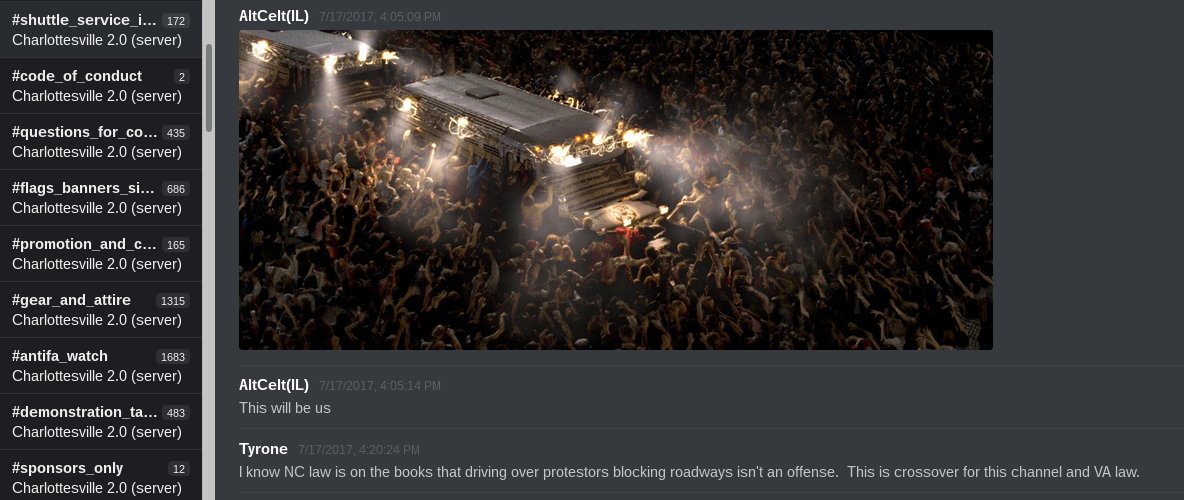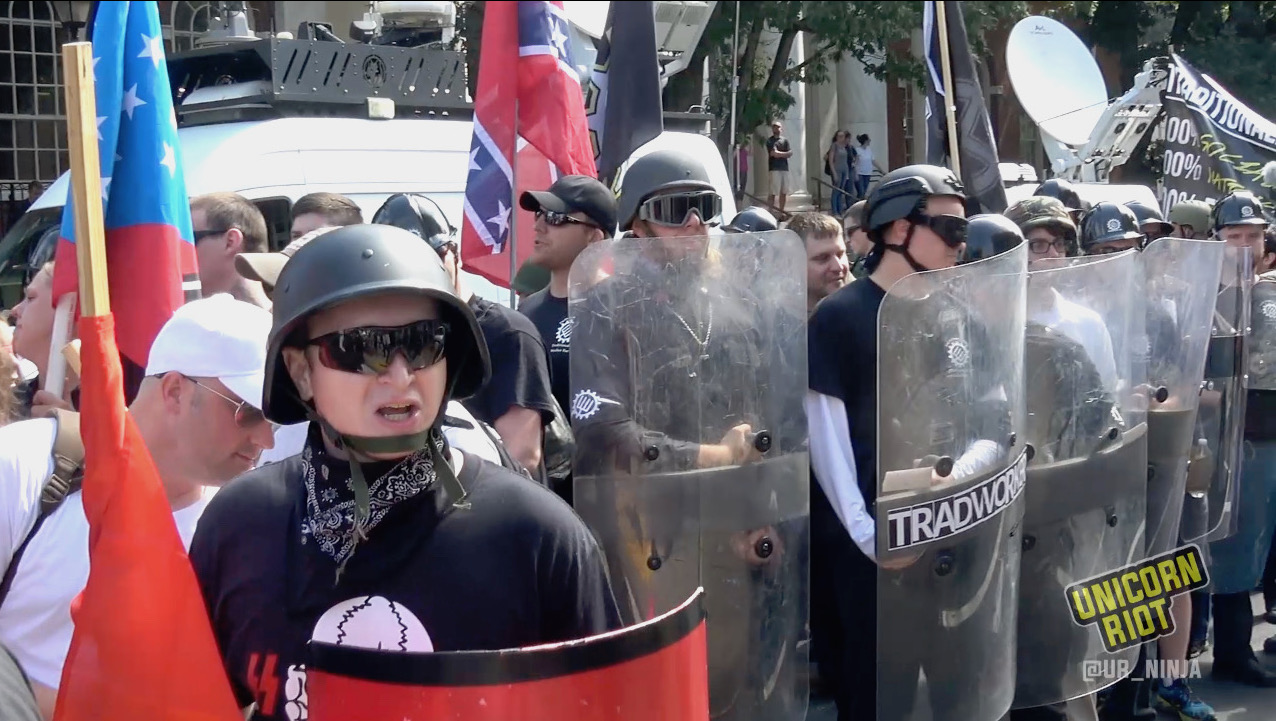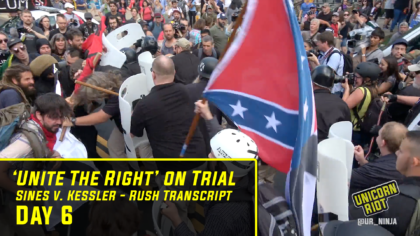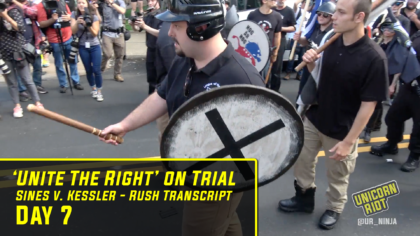‘Unite The Right’ Charlottesville Lawsuit Goes To Trial
Charlottesville, VA – Opening arguments took place the morning of Thursday, October 28 in ‘Sines et. al v. Kessler’, the lawsuit filed by civil rights nonprofit Integrity First For America against organizers of the violent and deadly August 2017 neo-nazi ‘Unite The Right‘ rally.
The case is brought by survivors of white supremacist violence on August 11-12 2017. The two key episodes litigated in the lawsuit involve the Friday, August 11 torch rally at the University of Virginia campus as well as the Unite The Right rally on Saturday, August 12 which ended in the downtown car attack by James Alex Fields, killing Heather Heyer and injuring many others, including several of the lawsuit’s plaintiffs.
Unite The Right organizers’ private communications are set to be unearthed during weeks of testimony. With millions of dollars of potential damages on the line, the long-delayed case will likely be a reckoning for the once-ascendant alt-right movement that revitalized white supremacy in America while riding former President Donald Trump’s coattails.
Unite The Right On Trial:
Rush transcripts: Day 1 | Day 2 | Day 3 | Day 4 | Day 5 | Day 6 | Day 7 | Day 8 | Day 9 | Day 10 | Day 11 | Day 12 | Day 13 | Day 14 | Day 15 | Day 16
Read Unicorn Riot's live tweets from trial proceedings - Day 1 | Day 2 | Day 3 | Day 4 | Day 5 | Day 6 | Day 7 | Day 8 | Day 9 | Day 10 | Day 11 | Day 12 | Day 13 | Day 14 | Day 15 | Day 16 | Day 17 | Day 18 | Day 19
Additional Resources via Integrity First For America: Trial & Deposition Video Transcripts • Searchable Database of Plaintiff’s Trial Exhibits
Content advisory: Discussions of racist violence.
Plaintiffs’ opening arguments were made by pro bono attorneys Karen Dunn and Roberta Kaplan, who told the jury that “this case is about violence and intimidation that was planned for months,” culminating in August 11 and 12. Dunn and Kaplan’s overture to the jurors focused on documented instances of brutality by white nationalists at the torch rally and Unite The Right. Their case makes heavy use of digital evidence that shows “the planning, executing, and celebration of racially motivated violence” in what alt-right organizers conceived of as “the battle of Charlottesville.”
Dunn told jurors that on August 11th & 12th, “white nationalists came prepared to commit violence,” “carried riot gear,” “marched in formation,” and “carried shields that…were used as weapons and not for protection” as well as “flagpoles that they used to beat people.”
The plaintiffs emphasized that one of the first columns of white nationalists to spark violence by marching directly into counter-protesters on the morning of Unite The Right was led by defendant Matthew Heimbach, head of the Traditionalist Worker Party (TWP), as well as co-defendants Michael Hill and Michael Tubbs, both leaders in the League of the South. (Later in the day on August 12, Tubbs also watched as Deandre Harris was badly beaten in the Market Street Parking Garage by a group that seemed to include men acting at his direction.)
Dunn also showed the jury video of the deadly car attack, reminding them that the car was driven by James Fields, who earlier that day had been seen marching alongside the neo-nazi group Vanguard America, one of the defendants in the lawsuit.
Communications cited in opening arguments included an email newsletter from defendant and alt-right celebrity Richard Spencer, who said that violence at the August 11 torch rally was “only the prequel” to the following day. Dunn also showed the jury a text exchange between Spencer and his co-defendant Chris Cantwell, on which Cantwell said he was “willing to risk a lot for our cause, including violence and incarceration but i want to coordinate and make sure it’s worth it for our cause.” Spencer replied, “It’s worth it, at least for me.“
Dunn said that the plaintiffs “aren’t suing the hundreds of white supremacists” who came to rally in Charlottesville, stressing that the suit only targets “the leaders and organizers who planned the violence and the most violent foot soldiers.”
“Many of the defendants wanted to build a white ethnostate, a country of only white people, and that could only occur with a violent race war…”
– Attorney Karen Dunn in Sines v. Kessler opening arguments
The plaintiffs’ case is supported by a litany of damning communications between various personalities and organizations behind the violent rally. In this civil suit, a “preponderance of evidence” rather than a lack of “reasonable doubt” is the evidentiary standard for proving liability for the unlawful conspiracy alleged by the plaintiffs.
Dunn said that the “conspiracy in this case began when Jason Kessler… reached out to… Richard Spencer, Eliott Kline [aka Eli Mosley] and Matthew Heimbach.” She said Kessler knew Spencer “would help attract an army for the Battle of Charlottesville” and that he “asked Heimbach to invite violent skinhead groups to the event.”
Kessler, a Charlottesville local, was the primary public face of the rally, while Kline referred to organizing Unite The Right as “my full time job.” By August 2017, Kline was also the leader of the neo-nazi group Identity Evropa (IE), taking over from IE’s former leader Nathan Damigo. (IE and Damigo are both also defendants in the case.)
Kline worked as an exterminator at the time he was planning Unite The Right and told his girlfriend at the time, Samantha Froliche, that he “wanted to kill Jews instead of cockroaches,” Dunn said. (Froliche was willingly deposed for this lawsuit.)
One text message from Jason Kessler to Richard Spencer captured the essence of the planning for Unite The Right, which the lawsuit alleges sought to hide intentional civil rights violations in the guise of protected political activity:
“We’re raising an army, my liege, for free speech, but for the cracking of skulls if it comes to it.”
– June 5, 2017 text message from Jason Kessler to Richard Spencer cited in Sines v. Kessler litigation
Dunn also cited a message from Matt Heimbach’s to Traditionalist Worker Party members that underscored the allegations of racist intimidation at the heart of the case:
“We need to scare these people, and the way to do that is with numbers and determination […] we need to send a message to the Jewish oligarchs and their minions.”
– Message from Traditionalist Worker Party (TWP) leader Matt Heimbach to TWP members regarding Unite The Right in Charlottesville, cited by plaintiffs’ attorney Karen Dunn in opening arguments for Sines v. Kessler
The plaintiffs also told the jury that the alt-right rally planners sought to purposefully incite street brawls in order to engage in violence. In messages obtained during discovery, Eliott Kline (aka Eli Mosley) said, “I think we are going to see some serious brawls on Charlottesville… and will see blood on some of those white polos LOL.”
Online discussions ahead of the rally showed that attendees were encouraged to bring flagpoles that could “double as spears” or were thick enough to be used as clubs. The flagpole discussion is an archetype of the strategy that plaintiffs accuse defendants of using to cover for their conduct at the rally. “Not only did plaintiffs and their co-conspirators discuss violence… they specifically discussed plans for violence… they knew they couldn’t openly discuss physical weaponry” so they discussed using mace, fists, and flagpoles as weapons that allowed for “plausible deniability“, Dunn told the jury.
The plaintiffs’ opening argument also referred to several leaked Discord messages in the planning chat which prefigured the deadly car attack.
Michael Chesny (aka Discord user ‘Tyrone’, the official transportation coordinator for Unite The Right), posted a fake advertisement for a tractor-like “multi-lane protester digestor” and said it “sure would be nice” to run counter-protesters over.
In a similar post in the ‘Charlottesville 2.0‘ Discord chat, Traditionalist Worker Party meme-maker Shane Duffy, aka ‘AltCelt(IL)’ on Discord, posted a picture of a vehicle driving into a crowd with the message “this will be us.”

Dunn read the jury numerous messages where the rally organizers seemed to celebrate the brutal violence after the fact, texting each other things like “great work.” A post by League of the South leader Michael Hill proclaimed that “our men acquitted themselves as warriors” in Charlottesville; another from Chris Cantwell applauded “commies” “bleeding” and “being sent to the morgue.” She also quoted a tweet Jason Kessler sent after after Unite The Right calling the death of Heather Heyer in James Fields’ car attack “payback.”
After the car attack, some defendants such as Cantwell and Heimbach expressed support for Fields by calling him in jail, and sending him letters, cards, and money, Dunn noted.
Several defendants have refused to cooperate with discovery at all – Dunn told the jury that the neo-nazi group Vanguard America “produced no materials in this litigation” while claiming they possessed no relevant materials – an unlikely claim given that the group had its own channel in the Discord chat used to plan Unite The Right.
Others named in the suit, such as Andrew Anglin and Robert ‘Azzmador’ Ray of the neo-nazi website Daily Stormer, have refused to appear or respond to the suit at all in any way. (Ray is currently a fugitive.) Eliott Kline aka Eli Mosely has also refused to cooperate in the case and was jailed for several days for contempt of court in 2020. Many defendants in the case have already had default judgements entered against them by the court due to their simply not responding to the lawsuit.
James Kolenich, defense counsel for Jason Kessler, Nathan Damigo, and Identity Evropa, aimed to direct jurors’ attention to the specter of ‘antifa’ as somehow responsible for violence at Unite The Right. While conceding that his clients may be “not likable,” Kolenich claimed that “antifa is a big part of this case…they don’t like what they call fascists or nazis” and characterized the premeditated violent ideations of his clients as merely being “scared” and “trying to put together an alt-right rally that could not be beaten down by these antifa.” According to Kolenich, the injured and traumatized protesters who filed the lawsuit were “innocent victims that were caught between the antifa and the alt right.”
Richard Spencer is also representing himself in court pro se. In his opening arguments, he was eager to distance himself from the event’s other organizers, insisting that he was “not involved in the logistical planning of the rally” and noted he was not present in the Discord chat used to plan Unite The Right. Like the other defendants, Spencer was keen to place blame for the violence of August 11 and 12, 2017 on the “policing strategy” of allegedly letting opposing groups fight instead of keeping them separated. Spencer claimed that what he called his “tough talk” and “bold words” did not prove his participation in any conspiracy to commit racist violence. Spencer aimed to cast any apparent preparations for violence on his part as mere preparations for self-defense because “I knew that if I was there antifa would want to come, antifa had attacked me physically on multiple occasions and I was wary of that.”
Christopher Cantwell, also appearing pro se, fell back into his racist shock jock personality in his opening arguments, dropping the n-word as he told a story about how he got fired from being a radio host while assuring the jury that he was sure he would win the case. Cantwell’s meme-laden diatribe in opening arguments, framing himself as a hyperbolic entertainer, seemed more aimed at drawing conservatives into neo-nazi thinking than convincing a jury of a logical defense to allegations of planning racially motivated violence.
The first witness to testify in the case was Natalie Romero, a former University of Virginia (UVA) student who was assaulted at the torch rally and also badly injured when she was struck by James Alex Fields’ Dodge Challenger in the car attack on August 12. Romero, who had been awarded scholarships but had to suspend her studies due to her injuries, told the court how she had her leg crushed, skull fractured, a tooth shattered, and struggled to regain her ability to walk after being hit by Fields’ car. She said she still hears the chants from the torchlight rally in nightmares. Romero’s torturous recovery process was described in detail to the jury, who were shown graphic photos of her injuries and medical documents from her treatment.
The second witness to testify was Devin Willis, another recent UVA graduate who was working with the university’s Black Student Alliance at the time of Unite The Right. Willis described being surrounded at the Thomas Jefferson statue during the torch rally and being maced, punched and kicked and called racial slurs.
Cantwell has reportedly received legal advice from former Aryan Nations leader Matthew Hale, currently imprisoned for trying to pay to have a federal judge killed. He seemed to relish using his cross-examination of Willis to intimidate – asking him “is everything okay?”, calling the torches at the August 11 rally “a nice touch” and forcing Willis to divulge, under oath, the full legal names of some of his friends who attended the counter-protest who he said he was “hesitant” to name due to threats.



